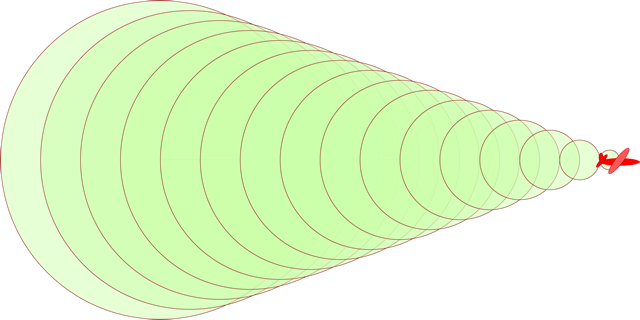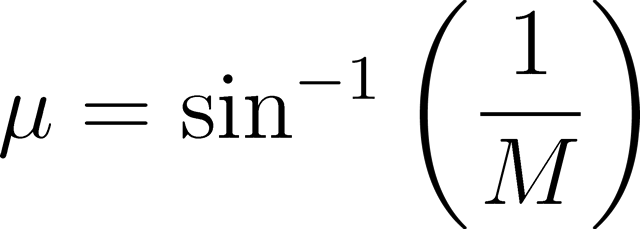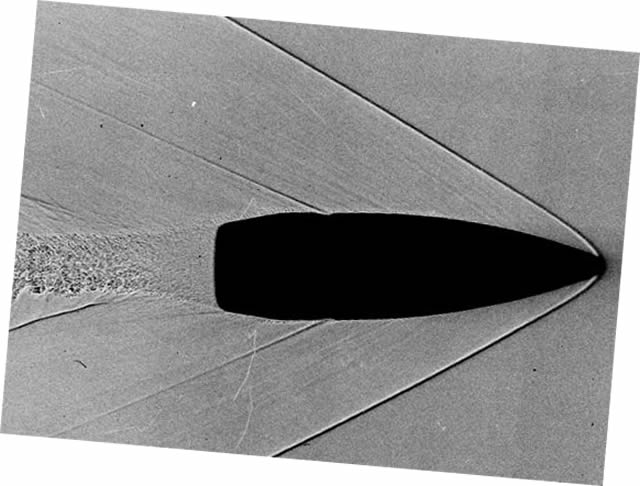When an object moves through the air it pushes the air in front of it away, creating a pressure wave. This pressure wave travels away from the object at the speed of sound. If the object itself is travelling at the speed of sound then these pressure waves build up on top of each other to create a shock wave, or sonic boom.


On the left, an object travelling at Mach 0.7. On the right, an object travelling at Mach 1.0.
One of the most common misconceptions about sonic booms is that they occur only as an object accelerates beyond Mach 1.0 (through the “sound barrier”) and not during supersonic flight. This is not the case. A sonic boom is continuously created as long as an object is travelling faster than the speed of sound, and this sonic boom trails behind the object, creating a Mach cone.

The shape of this Mach cone depends on the speed of the object, and the faster an object is, the narrower its Mach cone. For a supersonic or hypersonic object these cones can become very narrow and thus when the sonic boom from a high-speed aircraft reaches the ground the aircraft in question has already passed by and can be quite a distance away.
The angle of the Mach cone (μ) between the shock wave and the horizontal is simple to calculate from the object’s Mach number (M).

For an F-22 Raptor travelling at its maximum speed of Mach 1.82 the angle of the Mach cone formed is 33.3°. If the Raptor was flying at an altitude of one hundred metres then it would always be sixty-five metres away (horizontally, in the direction of travel) from where its sonic boom was detected and 120 metres in a straight line from the point of impact. At a distance of 120 metres a person on the ground is hearing (or rather, feeling) the sonic boom 350 milliseconds after it is emitted, assuming the speed of sound is 340 metres per second.
By looking at Schlieren photographs, which can image differences in gas density, we can see the shockwave created, find the Mach cone angle, and from that calculate the speed of an object moving through the gas.

In the photograph above the Mach cone angle is 28° and therefore the bullet must have been travelling at Mach 2.1 or 720 metres per second (assuming the speed of sound is 340 m/s).
can u please tell me how the calculation is made? //or an F-22 Raptor travelling at its maximum speed of Mach 1.82 the angle of the Mach cone formed is 33.3°. If the Raptor was flying at an altitude of one hundred metres then it would always be sixty-five metres away (horizontally, in the direction of travel) from where its sonic boom was detected and 120 metres in a straight line from the point of impact.//
A clue: you need to use some trigonometry. Draw a diagram to help you reason the problem out.
ya please tell me the equation (i mean something like 100tan(1/1.8))
Draw a diagram. Prove you’ve at least tried to work it out yourself.
I cant draw a diagram in here can I? I had question on this in a paper i tried to solve it
i drew a diagram but i couldn’t can u please help me
Host your diagram and imgur and post a link here.
Mach_angle=arcsin(1/M)
What do you reckon the Mach cone of this would be? http://imgur.com/xlEhGdB
Depends on how fast it’s going.
Maybe I should rephrase. How fast do you think this would be able to go? And any other remarks of the plane design?
It is absolutely impossible to say. How powerful are the engines? What is shape of the the cross-section? How heavy is it? There are too many unanswered questions. For reference, most fifth-generation fighters have cruise speeds of around 1300-2000 km/h, with maximum speeds of 2000-2400 km/h.
Expect the engines to be able to deliver a thrust-to-weight ratio of 1.2. This plane is designed as an interceptor that would be made in 1965.
Great article.
What’s a sonic boom
What’s the diffrence between a sonic boom and the dopler effect
A sonic boom is a shock wave produced by an object travelling faster than the local speed of sound.
Well sonic booms are a real thing, and “the dopler effect” is something you just made up.
The doppler effect is very real Mr Reid. Observed with both sound and light.
I don’t think I said it wasn’t?
GRAMMY CITY